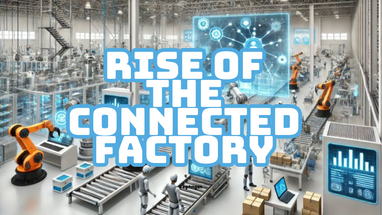Jun 27th 2024
The Emergence of the Connected Factory: Digital Revolution in Manufacturing
Manufacturers are facing the resource-intensive route that digital transformation often requires as they embrace it more and more. In order to satisfy the constantly shifting demands of the market, develop a new workforce, and support sustainability, they must strive for strategic harmony, which is especially important as they negotiate digital agility. In order to create an environment that will support adaptive manufacturing in the future, it is imperative that data silos be broken down and that the C-suite, IT, and OT work together.
Today's manufacturers understand how important digital transformation is to ensuring future prosperity in the face of ongoing market changes and economic uncertainties. The complete potential of Industry 4.0 is still out of reach for many, despite soaring investments in technological solutions. There is still a large visibility gap, as only a small percentage of manufacturers track and monitor items in real time across their production processes. Prioritizing technology that generates rapid returns is essential for C-suite executives. Manufacturers may create dynamic, data-rich ecosystems on their production lines by integrating digital capabilities into their assets. This fine-grained understanding of the production process enables ground-breaking breakthroughs in innovation and visibility, but it also draws attention to the glaring regional differences in the uptake of new technologies. All-encompassing digital technology efficiently support supply chain flexibility, allowing producers to quickly adjust to shifting consumer needs and market trends. Even with these advancements, industry leaders continue to place a high priority on fully integrating and utilizing these technologies to close the visibility gap, as it sets the standard for upcoming investments and operational plans.
The workforce is changing as a result of the use of digital tools as manufacturing advances into the future. Workforce management software is emerging as the new norm, and tablets and mobile computers are starting to become as prevalent as wrenches and drills. In the meantime, wearables, machine vision, and augmented reality technologies are seeing a sharp increase in acceptance, which indicates a fundamental change in the way work is done and managed. Stewardship becomes an important consideration when navigating this digital change. There is a blurring of the lines between who is responsible for using technology to improve worker experience and production floor performance. Even though OT usually takes the lead, the C-suite and IT both have a big say in what is decided. Each group aims to improve the interaction between human skill and digital innovation by bringing a distinct viewpoint to the table. But such a dynamic cuts beyond conventional departmental lines, highlighting the necessity of a cohesive approach. The industry's collective expertise suggests working together as each group tries to guide innovation. Creating a workforce that is as sophisticated as the technology it uses and prepared for an industrial environment that is always changing is the obvious objective.

The digital transformation of manufacturing has led to a greater emphasis on quality error-proofing on the production floor. As sophisticated automation proliferates, there is greater opportunity for achievement as well as pressure to manufacture and provide goods and services as fast and precisely as feasible. Furthermore, producers face pressure to achieve more with less resources in a world where competition is fiercer than ever. Real-time visibility and quick response times are critical for manufacturers to uphold high standards. To improve accuracy and control on the plant floor, decision-makers need automated systems with sensors and real-time data analytics. Cobot integration promises to improve workflows in ways that previous automation was unable to, adding flexibility and lowering human error rates. It is also anticipated that the data gathered by these intelligent systems would be a priceless tool for continuing, continuous development. Businesses that can leverage their data to its fullest potential will be able to make well-informed strategic decisions, enhance the quality of their products, guarantee regulatory compliance, and exceed customer expectations.
A new era of extraordinary efficiency and flexibility is being ushered in by Industry 4.0: smart factories. These factories are outfitted with cutting-edge systems that facilitate connectivity throughout the plant. Manufacturers will benefit from increased connection, better decision-making, and increased sustainability by adding more employees and utilizing the power of adaptable solutions that promote communication between C-suite, IT, and OT. They're adapting and leading the way toward industry excellence with a united approach to innovation, setting new benchmarks in a global economy that is changing quickly. These developments will reshape manufacturing excellence, giving businesses a competitive edge and heralding a sea change in the sector.
As manufacturers navigate the complexities of digital transformation, it's crucial to embrace the technologies that drive immediate value and foster a cohesive strategy across all departments. By breaking down data silos and encouraging collaboration between the C-suite, IT, and OT, manufacturers can unlock the full potential of Industry 4.0 and create a more dynamic, data-rich production environment.
Are you ready to lead the way in manufacturing excellence? Join us in embracing digital transformation and building the smart factories of the future. Connect with our experts today at 1-888-600-3080 or complete our contact form and learn how our innovative solutions can help you stay ahead of the curve and achieve unprecedented efficiency and flexibility.

